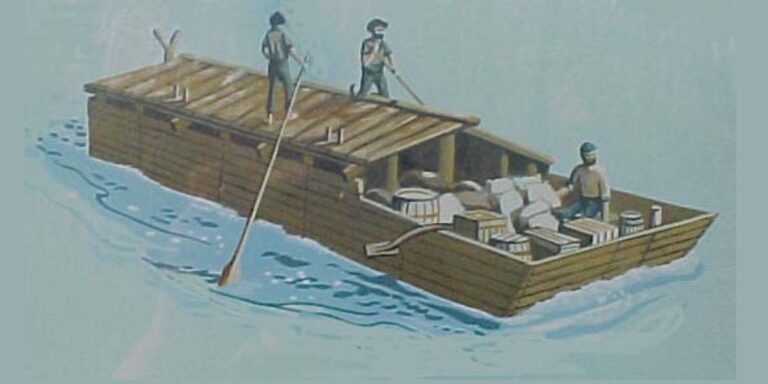Flatboats are an iconic representation of American river transportation, embodying a rich history that dates back to the early 19th century. These flat-bottomed vessels played a crucial role in the movement of goods and people along the nation’s rivers, particularly the Ohio and Mississippi Rivers. This article explores the history, design, and significance of flatboat, as well as their modern implications and related FAQs.
What is a Flatboat?
A flatboat is a simple, rectangular-shaped vessel characterized by its flat bottom, designed primarily for transporting cargo. Unlike traditional boats, flatboats are not built for navigation in deep waters; rather, they thrive in shallow river systems. The design allows them to carry heavy loads, making them ideal for transporting agricultural products, lumber, and even livestock.
Historical Background
The origins of flatboats can be traced back to the early settlers of North America, who needed efficient means to transport goods across rivers. As settlements expanded westward during the early 1800s, flatboats became increasingly important for trade and migration.
The Rise of Flatboat Transportation
Flatboat transportation peaked between the late 18th and mid-19th centuries. Settlers utilized flatboats to ferry goods from rural areas to bustling river towns. The construction of these vessels was often a community effort, with families banding together to build boats that could carry their surplus produce to markets.
Construction Techniques
Flatboats were typically constructed from readily available materials like timber. Builders would create a rectangular frame and cover it with planks, ensuring that the vessel could float in shallow waters. The design allowed for maximum cargo capacity, and additional features such as wooden railings and a canopy for protection against the elements were often added.
Flatboats in American Culture
Flatboats played a significant role in shaping the economy and culture of early American society. They facilitated trade and migration, helping to establish new communities and markets.
Trade and Economy
The flatboat trade contributed to the growth of cities along the riverbanks. Towns like Cincinnati and New Orleans thrived as major hubs for commerce, with flatboats serving as the backbone of the regional economy. Farmers and merchants relied on these vessels to transport their goods, creating a network of trade that spanned vast distances.
Migration and Settlement
The flatboat also served as a means of migration for many families seeking new opportunities in the West. Entire households would load their belongings onto a flatboat and travel downstream, settling in newly established territories. This movement of people played a crucial role in the westward expansion of the United States.
The Decline of Flatboats
Despite their importance, the era of flatboats began to wane in the late 19th century. Advances in technology and changes in transportation methods led to their decline.
The Impact of the Steamboat
The introduction of steamboats revolutionized river transportation. These vessels could navigate deeper waters and travel faster than flatboats, making them a preferred choice for transporting goods and passengers. As steamboats became more prevalent, flatboats were gradually phased out of commercial use.
Changes in Transportation Infrastructure
The construction of railroads in the late 1800s further diminished the need for flatboats. Railroads offered a more efficient means of transporting goods over land, making flatboats less relevant in the evolving transportation landscape.
Modern Relevance of Flatboats
While flatboats are no longer a primary mode of transportation, their legacy endures in various ways. They serve as a historical reminder of America’s riverine past and have found a place in modern recreational activities.
Flatboats in Tourism
Many river communities have embraced the historical significance of flatboats by promoting them as tourist attractions. Riverboat tours often feature flatboat replicas, offering visitors a glimpse into the past. These experiences educate tourists about the importance of flatboats in American history and culture.
Recreational Uses
Flatboats have also made a comeback in recreational settings. Modern flat-bottomed boats, designed for fishing and leisure activities, borrow elements from traditional flatboat design. They are particularly popular on shallow rivers and lakes, where their stability and capacity make them ideal for family outings and fishing trips.
Environmental Considerations
Today’s flatboats and their modern counterparts are often constructed with environmental considerations in mind. Many manufacturers use sustainable materials and design techniques that minimize environmental impact, aligning with the growing emphasis on eco-friendly practices in recreational boating.
Conclusion
Flatboats hold a special place in American history, representing a unique chapter in the evolution of transportation. From their crucial role in trade and migration to their decline with the advent of steamboats and railroads, flatboats reflect the dynamic nature of America’s development. Today, they continue to capture the imagination of tourists and recreational enthusiasts, serving as a bridge to the past while adapting to modern needs. As we honor this historical vessel, it’s essential to remember its contributions to shaping the communities and economies of the American landscape.
FAQs
What materials were traditionally used to build flatboats?
Flatboats were primarily constructed from timber, often sourced locally. Builders used planks to create a rectangular frame that could withstand the rigors of river travel.
How did flatboats differ from other boats?
Flatboats feature a flat bottom and a rectangular shape, designed for shallow rivers. Unlike traditional boats, they are not meant for deep-water navigation and are built for maximum cargo capacity.
Why did the use of flatboats decline?
The introduction of steamboats and the expansion of railroads provided faster and more efficient means of transportation, leading to the decline of flatboat use in commercial trade.
Are there modern versions of flatboats?
Yes, modern flat-bottomed boats, designed for recreational use such as fishing and leisure activities, have elements that harken back to traditional flatboat design.
How can I experience flatboats today?
Many river communities offer historical tours featuring flatboat replicas, providing educational experiences about their significance in American history. Additionally, recreational flat-bottomed boats are available for rent at various lakes and rivers.

